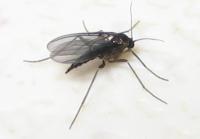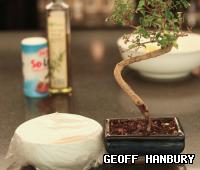The Ultimate Guide to Killing Fungus Gnats
 Female fungus gnat taken by Erik Burton
Female fungus gnat taken by Erik BurtonA comprehensive review of the various methods that can be used to combat this common horticultural pest.
They are one of the most common indoor plant pests, affecting thousands of households around the UK each year, and, as anyone who has had a major infestation can attest to, fungus gnats are as hardy and tenacious as they are annoying!
Fungus gnats are drawn to moist conditions and organic matter in plant soil and can be identified in their adult form as they resemble tiny mosquitos, with long legs and a smaller, squat body. In their larval form they are white or translucent with a distinctive black head and can be found wriggling around just below the surface of the plant soil.
For the most part, fungus gnats are totally harmless as they lack the apparatus to bite humans or animals, but this doesn’t stop them from being a major annoyance and fairly unhygienic. However, while adult gnats can’t directly damage plants, larval gnats feed on plant roots, over time impeding plant growth and even killing younger plants.
There are no-end of folk remedies floating around online forums, but with so many different purported solutions, it is hard to know which is the best one to use.
I’ve decided to put my recent gnat infestation to good use by experimenting with the most common gnat solutions to find out what the most effective gnat-killing remedy is.
1. Quick Fixes
Drying Out Soil
As their name suggests, fungus gnats feed predominantly on fungus and other organic matter, and are therefore totally reliant on moist conditions. Most infestations happen as a result of keeping plants a little overwatered. So, by waiting longer between watering, the theory goes you can make your plant soil inhospitable to gnats.
Method
- Use an old fork to turn up around 2cms of soil in the plant. This exposes the larvae and eggs and helps dry out the soil more quickly
- Wait until the soil is dry to a depth of about an inch and a half before watering again
Did It Work?
It did reduce the number of larvae wriggling about underneath the soil, but it didn’t come close to eliminating the problem completely. Because many plants can’t be chronically under-watered for a long time, it means that once you resume normal watering, the gnats will just multiply again.
Effectiveness: 4/10
Cider Traps

Gnats are drawn to apple cider vinegar, which makes it the perfect bait in this handy trap.
Method
- Fill a wide brimmed jar or bowl (it doesn’t need to be a huge bowl, a small jam jar or dip bowl would work perfectly) with apple cider vinegar, cider or beer
- Add a drop or two of washing up liquid to get rid of surface tension so that the gnats will drown
- Cover the rim with cling film and pierce with a fork a number of times
- The gnats will now crawl through the small holes in the cling film, but will be unable to escape and will drown in the vinegar
 Did It Work?
Did It Work?
The main limitation of this method is that it only kills adult gnats, and therefore doesn’t completely break the lifecycle, or do anything to kill the 100s of larvae and eggs which will still remain in your plant soil. That said, it did kill a fair deal of adult gnats, meaning that the breeding population of gnats was heavily curtailed and it therefore reduced overall numbers.
Effectiveness: 4/10
Potato Slices
Gnat larvae love raw potato, which makes potato slices a great, low cost way to measure how heavy the infestation is, as well as get rid of some larvae in the process.
Method
- Slice or dice a potato into inch wide blocks
- Bury potato pieces just beneath the soil surface
- Wait 4-8 hours and then pull out the chunks. If the infestation is heavy, the potato will be literally crawling with larvae
- Throw away the potato to get rid of all the larvae cling-ons
 Did it Work?
Did it Work?
Each potato slice can only really get rid of dozens of larvae at a time. Since adult gnats can lay 200-300 eggs at a time, getting rid of a heavy infestation with potato slices alone would be impossible. However, as a way to measure gnat population size and see if your other methods are working, it is fantastic.
Effectiveness: 5/10
Chamomile Tea & Cinnamon
This was one of the most popular remedies touted by gardeners on internet forums, so I approached this method with high hopes! Chamomile and cinnamon are powerful natural fungicides, so the logic was that by killing off the gnats’ primary food source, it makes your plant soil less hospitable and therefore reduces population.
Method
- Brew a litre of strong Chamomile tea with boiling water, allow it to cool and mix tea with 4 parts water
- Use tea mix to water plants as usual
- Sprinkle Ceylon cinnamon all over the surface of the soil for a fungicidal double whammy
- Repeat for 3 weeks, or until gnats are gone
Did It Work?
Within days the chamomile/cinnamon dousing had dramatically reduced the gnat populations, however, over the next few weeks it didn’t kill off the remaining population, which was still big enough to be troublesome.
Effectiveness: 6/10
Sand/Perlite Surface Layer
A layer of sand or perlite above the plant soil is said to encourage fast draining and prevent the gnats from burrowing into your soil.
Method
- Remove top inch layer of plant soil and throw it away
- Replace this soil with an inch of course sand or perlite
Did It Work?
The sand layer did seem to reduce the population somewhat, but it was by no means a complete solution. However, it did seem to be a great preventative measure, which could stop infestations from setting in in the first place.
Effectiveness: 6/10
2. Weapons of Gnats’ Destruction
If these cheaper, natural methods still haven’t managed to rid you of your gnat infestation, then you can escalate things with these more powerful gnat killers.
Hydrogen Peroxide
A peroxide solution apparently kills larvae and eggs on contact, effectively killing off all infant gnats and disrupting the lifecycle. Because adult gnats only live for around 7 days, this method can purportedly totally eradicate a gnat infestation in a fortnight.
You can buy hydrogen peroxide from any high street pharmacy like Boots, or online here.
Method
- Mix 1 part 9% hydrogen peroxide with 6 parts water
- Allow top layer of soil to completely dry out before drenching the soil in the peroxide solution
- After fizzing for about 30 seconds, hydrogen peroxide will break down into oxygen and water, both of which are harmless to your plants
Did It Work?
The peroxide drench was very effective in killing larvae, although it never completely killed off the gnat population within the 3 weeks I used it.
Effectiveness: 7/10
Food Grade Diatomaceous Earth
Although diatomaceous earth (DE) sounds intimidating, it is actually completely natural and non-toxic. It is made from microscopic fossil shards and essentially shreds the larvae and the gnats upon contact.
Although the microscopic shards are lethal to small insects, it is harmless to humans and animals - doctors even tell people to eat it to get rid of intestinal parasites! However, DE will kill all other insects, including worms and other helpful animals.
You can buy DE from garden centres or on Amazon. If you buy DE, make sure you buy the food grade version, not the product made for pools.
Method
- Apply a layer of DE to the top of the soil, or mix it into soil mix if you are repotting a plant
- It is a good idea to wear a mask while handling DE
Did It Work?
DE was very effective in killing off both larvae and gnats, with good results within a week. After around three weeks, the population was all but gone. Although it is effective, it is also quite expensive and because it indiscriminately kills all small insects, it can be a risky choice, especially for outdoor plants.
Effectiveness: 8/10
Bacteria Thuringiensis
Bacteria Thuringiensis (BT) is a natural bacteria which kills a large range of pests. A particular genus which specifically kills fungus gnats can be bought under brand names such as Gnatrol, however these products are very expensive to buy in the UK, working out at around £25 for a tiny 250ml bottle. If all else fails and you do need to buy it, it’s worth trying to find it on discount here, and failing that you can buy it on Amazon.
Fortunately, a much cheaper option is to buy something called Mosquito Dunks, or Mosquito Bits, which contain the same bacteria, although in a lower concentration. You can find it on Amazon for a fraction of the price of Gnat Off.
Method –  Mosquito Bits
Mosquito Bits
- Sprinkle bits on soil, generously covering every bit of the surface
- Pour a handful of bits into a gallon of water, and leave it to infuse for a day or two
- Use this infusion to water the plants as normal
Does It Work?
 BT is very effective in killing off the larvae and will disrupt the lifecycle of the population, meaning that you can be totally gnat free within a fortnight or so. Within days of applying the bits, you’ll notice
a huge dip in gnat numbers.
BT is very effective in killing off the larvae and will disrupt the lifecycle of the population, meaning that you can be totally gnat free within a fortnight or so. Within days of applying the bits, you’ll notice
a huge dip in gnat numbers.
However, if you have a lot of plants which are infected, buying BT products can get expensive, especially if you need the more powerful Gnatrol mix!
Effectiveness: 9/10
The Ultimate Gnat Killing Solution
While by themselves the different methods I used had varying degrees of success, you can use a number of them in conjunction to completely eradicate your gnat problem fairly quickly. While diatomaceous earth and mosquito dunks are very effective, they can be pricey and waiting for the items to ship after buying them online can take a long time. Therefore, I’ve put together this gnat killing regime which is as effective as it is cheap, and it should get rid of all but the most resilient of gnat infestations.
- Till the first inch or so of soil, bringing larvae and eggs to the surface and increasing air circulation
- Sprinkle ground cinnamon all over the surface of the soil
- Set up vinegar traps around the plant and change them daily. Monitor the number of gnats caught every day to see if gnat population is dying off
- Insert slices of potato and leave in soil for 8 hours before throwing away. Repeat daily
- Do not water the plant until the top layer of soil is totally dry
- When top soil is dry, thoroughly drench the soil with the hydrogen peroxide solution
- Once the hydrogen peroxide solution has stopped fizzing, repeat step 1 onwards
Repeat steps 1 to 7 for a fortnight. If the gnats are still not wiped out, or at least heavily curtailed, by this regimen, it would seem you are dealing with “Rambo gnats”. In this case, you’re going to have to invest in the more expensive options and follow these steps:
- Sprinkle diatomaceous earth all over the surface of the soil
- Till the first inch or so of soil, bringing larvae and eggs to the surface and mixing the diatomaceous earth into the soil
- Keep vinegar traps around the plant
- Continue to leave potato slices in the soil each day and remove after 8 hours
- Soak mosquito bits in a gallon of water. Use this “dunk-mix” to thoroughly drench the plant when the top soil is dry
- Repeat step 1 onwards
This article was written by Geoff Hanbury.
Photo of fungus gnat taken by Erik Burton and used under Creative Commons license.
Filed under General.


